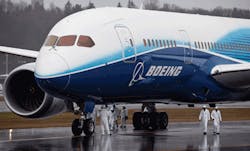“The emergence of strong economies in the BRIC [Brazil, Russia, India and China] countries, along with the rapidly growing demand for air transport in these regions, will drive a regional jet market for the next two decades.” That was last October’s opinion of Dick Slansky, senior analyst with ARC Advisory Group (ARC, www.arcweb.com), Dedham, Mass., about use of the 100-150 passenger jets used in domestic routes worldwide. In the October 2010 ARC Insights “Global Aerospace and Defense Trends for 2011 and Beyond,” Slansky also said, “With a huge backlog of orders for commercial aircraft makers Boeing and Airbus, and the demand for regional air transport, the future looks very rosy indeed.”A year later, the 28-year veteran of Chicago-based Boeing Co. (www.boeing.com) stands by his assessment. “Everything’s right on schedule. That’s because the timeframe in aerospace manufacturing is a lot longer.” For example, Boeing has more than 850 orders for its two-engine 787 Dreamliner, Slansky states. “They’re almost three years late but, even so, they’ve only had about four cancellations. What this says is that air carriers really want this plane.” That’s primarily because the 787 is a carbon-fiber composite. “Couple that with more fuel-efficient engines, and you have an airplane that can go very long distances,” he remarks. Boeing indicates its 787-8 will carry 210-250 passengers for approximately 8,800-9,400 statute miles, while its 787-9 will carry 250-290 passengers for approximately 9,200-9,800 nautical miles. “We’re moving to an era of ‘plastic’ airplanes, made of composites,” Slansky says as he talks about the 787. Strength and fuel efficiency drive the shift. “They have a 33 percent better strength-to-weight ratio, which means you can make an airplane that weighs considerably less. And less weight translates to less fuel.”Besides the 787, Slanky’s former employer sees other roses in its future. In mid-June 2011, Boeing announced increased production rates for its next-generation two-engine 737 jet to 42 planes per month. Once that rate is implemented in the first half of 2014, Boeing expects to build on average two 737s each workday and nearly 500 airplanes each year.Paris brought debuts, sales This year’s Paris Air Show, in late June, also brought good news for Boeing as well as its commercial competitor Airbus (www.airbus.com), Blagnac, France. Boeing debuted its 747-8 Intercontinental and Freighter models. And CIT Aerospace, a unit of Livingston, N.J.-headquartered CIT Group Inc. (www.cit.com), committed to 50 of Airbus’ A320neo (new engine option) aircraft. Overall, Airbus won approximately $72.2 billion worth of business for 730 aircraft: 312 memoranda of understanding worth $28.2 billion, and 418 firm purchase orders for approximately $44 billion. More roses bloomed in July 2011. Boeing forecast a $150 billion market for 1,320 new passenger airplanes in India over the next 20 years. Then Airbus and American Airlines, a wholly-owned subsidiary of AMR Corporation (www.amr.com), Forth Worth, Tex., signed a firm contract for American to acquire 260 Airbus-A320-family aircraft, including 130 which will feature Airbus’ new engine option. Also, all Airbus’ aircraft will feature sharklets, which are large fuel-saving wingtip devices.At the end of July 2011, Montreal-headquartered regional-jet manufacturer Bombardier Inc. (www.bombardier.com) announced a net income of $211 million, an increase of $73 million over the company’s last fiscal year. Currently the world’s third largest commercial aircraft manufacturer, Bombardier also reported a strong backlog of $56.9 billion, compared to $52.7 billion last fiscal year. The company also noted 43 firm orders totaling $2.8 billion for its C-Series aircraft. Rival regional-jet manufacturer Embraer’s order book shows more robustness. On March 31, 2011, the São José dos Campos, Brazil-based company (www.embraer.com) had 261 firm orders on backlog, all in Embraer’s 170/190 commercial jets having seating capacity of 70-120 passengers. Then, on Aug. 11, 2011, the company delivered the first E-190 aircraft to China’s CDB Leasing Co., Ltd. (CLC). CLC has ordered 30 Embraer 190s, of which 20 are firm orders and 10 are options. China Southern Airlines will operate the aircraft. With such actual and projected growth, though, Boeing and maybe Airbus face at least two pests in their respective rose gardens. “Boeing is reexamining its global supply chain, which may be overextended now,” Slansky says. Workforce management also demands attention. “It takes time to attain certain skill levels, so in moving that workforce around to establish new production lines, issues will arise,” he forecasts. Pests also include other regional jets. Slansky mentions the Suhkoi Superjet 100, Mitsubishi MRJ, and Commercial Aircraft Corporation of China, Ltd. (COMAC) ARJ-21. “The regional-jet market is really going to be the big market in the next 10-15 years,” he forecasts. Could one company’s pest be another’s rose? That seems likely.Airbus (www.airbus.com)AMR Corporation (www.amr.com)ARC Advisory Group (ARC, www.arcweb.com)Boeing Co. (www.boeing.com)Bombardier Inc. (www.bombardier.com)CIT Group Inc. (www.cit.com)Embraer (www.embraer.com)
Subscribe to Automation World's RSS Feeds for Perspectives
Subscribe to Automation World's RSS Feeds for Perspectives
About the Author
C. Kenna Amos
Contributing Editor
Sign up for our eNewsletters
Get the latest news and updates

Leaders relevant to this article:
